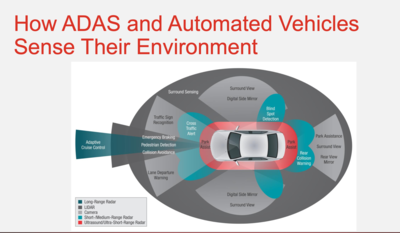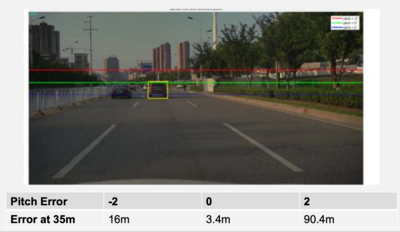BUSINESS
ADAS and the Art of Vehicle Modification
Tips For Working With Digital-Age Vehicles
By Douglas McColloch
How ADAS and Automated Vehicles Sense Their Environment

All ADAS sensors are not alike, and understanding how each type “sees” its surroundings is crucial for proper recalibration and test protocols. Given that automatic emergency braking with forward-looking radar will be a standard feature on all vehicles sold in the United States by 2025, it’s never been more crucial for parts manufacturers and shop technicians alike to take ADAS requirements into account when designing products and/or reviewing installation procedures.
The advent of advanced driver-assistance systems (ADAS) on original-equipment manufacturer (OEM) vehicles has posed numerous challenges to the automotive industry—none more so than the automotive aftermarket, where customization and accessorization are the name of the game. On the other hand, ADAS also presents numerous opportunities for the manufacturer or shop owner who understands how these systems can work in tandem with aftermarket parts and accessories.
A SEMA Education seminar, “Safely Modifying Vehicles With ADAS—Powered by WTC [Wheel & Tire Council],” featured a panel of industry experts who explored this topic in detail, with a review of issues that are common to technicians working with ADAS. Moderated by Mike Spagnola, SEMA CEO, the panel consisted of Brian Daugherty, chief technology officer for the Motor & Equipment Manufacturers Association (MEMA); Scott Brown, founder of Diagnostic Network; and Nick Dominato, senior vice president of product for asTech.
New Technology, New Challenges
ESR Installation
4.1 External Mechanical Interfaces
4.1.1 Mounting Height
For base ACC-only applications, the mounting height of the center of the ESR on the vehicle should be 300 mm to 860 mm from the road surface. For ACC with Stop-and-Go applications, the mounting height of the center of the ESR on the vehicle should be mm to 860 mm from the road surface. The illustration below shows the allowable mounting zones in green. The zones in yellow indicate potential zones with extensive radar and vehicle testing required. The zones in red indicate zones that are not allowed.

Sensors sometimes need to be relocated to accommodate a change to the vehicle, and the OE manufacturers allow for a certain amount of leeway in that regard. In this example from Delphi, the suitable areas for relocating sensors for Ford’s adaptive cruise control are highlighted in green. The yellow-shaded areas indicate placement where proper ADAS functioning could be problematic. The red zones are areas where the sensors simply won’t work properly.
An amalgam of new and rapidly evolving technologies, ADAS presents the would-be modifier with a considerable learning curve. First, the processes of repairing, replacing or recalibrating can be a difficult and time-consuming task. Second, there are numerous suppliers and varieties of technologies, sensors and systems on the market, and there is very little industry standardization at present. Third, OE manufacturers rely on multiple suppliers for ADAS sensors—sometimes within one vehicle model—and suppliers for a given sensor can change within a single model year. Also, there are constant software updates that the builder or installer must stay aware of.
All of this results in hundreds of discrete ADAS repair, replacement and calibration procedures across the vehicle market.
One other thing: Calibration processes—often the most crucial step in ADAS componentry on modified vehicles—can often be “spoofed,” resulting in inaccurate readings. This can happen purely by accident when a smaller target is positioned too closely to a vehicle sensor due to a lack of usable shop space. Proper calibration also requires a near-level floor surface, and that can also pose
a challenge.
“You have hundreds of camera targets and dozens of radar targets,” Daugherty observed. “If you’re running a full-service shop that works on all makes and all models, you should theoretically have all of these [targets] in your inventory to handle everything that comes in for service, and that can get to be very expensive.”
All of this assumes an even greater importance when one considers that virtually every new passenger car sold in the United States by the end of this year (for trucks and SUVs, it’s 2025) will come standard with automatic emergency braking, which utilizes forward-looking radar. Bottom line: Customizers of newer-model vehicles will have no choice but to learn how to work with ADAS technologies if they intend to modify a vehicle while keeping all of its onboard safety systems working within factory spec.
Case Study: Lifted Pickups
Suspension components, wheels and oversize tires for pickups and SUVs are perennially among the most popular parts in the specialty-equipment aftermarket, and vehicles equipped with those products are among the most likely to need repositioning and/or recalibrating of OE ADAS sensors. Any change in tire diameter, wheel offset, backspacing or vehicle ride height will likely throw off sensor readings and necessitate reworking of the ADAS system.
A 2-in.-lifted Ford pickup was studied as an example that shops and installers are likely to encounter, and it’s one that provides a platform for reviewing best practices. (Much of the following advice applies to lowered vehicles as well.)
“The aftermarket isn’t a stranger to resets and calibrations following a vehicle modification,” Dominato noted, mentioning speedometer recalibrations, wheel realignments or headlight adjustments that shop techs typically make after installing a suspension lift or oversize tires. “ADAS is just one more thing we have to think about.”
Dominato explained that a vehicle’s radar system must be set at a specified level, often +/- 0.1 to 0.3 degrees, or to bubble level.
“It’s got to be at a very specific level to function,” he said, and the floor must also be level—in this case, within +/- 7 millimeters, which equates to changing the angle of the radar sensor 0.4 degree. “When we think about installing a leveling kit and lifting the front of a vehicle two inches, you’re going to knock off that sensor by half a degree. What does that mean when we install a lift kit on that vehicle? It means we’re going to knock that radar sensor way off its specification.”
Another thing to remember: Radar height/angle affects the effective range of the radar. For instance, a sensor that’s off by 1 degree subtracts approximately 10% of the radar’s effective range; a 2-degree misalignment increases that number to 25%; and a 3-degree misalignment subtracts 50% off the radar’s effective range. “So when we lift a vehicle, we’re affecting both its effective distance and its signal strength,” Dominato said.
Onboard cameras are also impacted by lifting and lowering. A camera’s distance estimation (the distance it reads between it and other objects) is heavily dependent on the camera’s height and pitch angle. That’s because the camera uses the horizon line to calculate distance, and changes in its angularity will affect its ability to read the horizon line correctly.
Even the smallest variation in camera pitch can lead to some dangerously inaccurate readings. A camera pitch error of only 2 degrees can result in an inaccurate reading of up to 16 meters; a pitch error of -2 degrees can lead to wrong reading of up to 90 meters—the length of a football field.
Often, ADAS sensors will need to be relocated, such as after installing a set of auxiliary lights, a winch bumper or other accessories that can impede a sensor’s ability to monitor road conditions. Fortunately, most OE manufacturers provide some measure of accommodation in their vehicle designs, and consulting the OE or supplier installation manuals can provide guidance.
Finally, different OE manufacturers will mandate different ADAS test and calibration procedures.
“There is no one-size-fits-all answer,” Dominato noted. “Each OE manufacturer must be approached separately, and do not assume that what works for one OE manufacturer is going to be suitable for others.”
Elevation Misalignment (deg)

Setting the proper pitch angle (i.e., horizon line setting) is also essential in order for a sensor to calculate the correct distances between itself and other objects, particularly on lifted vehicles. A pitch error of only 2 degrees above the actual horizon—the “green line” in this photo—can cause the sensor’s distance reading to be off by as much as the length of a football field.
 About SEMA Garage Detroit and ADAS
About SEMA Garage Detroit and ADAS
Located in Plymouth, Michigan, SEMA Garage Detroit will offer manufacturers access to advanced product-development tools and equipment, a state-of-the-art emissions testing lab, an ADAS research and development center, and expert technicians who will help bring products to market. The 45,000-sq.-ft. facility will give aftermarket parts manufacturers access to sophisticated resources that are typically accessible only to large-scale manufacturers.
“Our research goal with the ADAS Center is to find out what happens when we modify a vehicle,” SEMA CEO Mike Spagnola said. “Right now, we really don’t know exactly what’s going to happen when we lift a vehicle three inches to five inches, or when we install a larger tire. We have a feel, but we really want to better understand and research what happens when we raise or lower vehicles and the proper procedures to recalibrate them. The goal is to create a series of best practices, working with the collision industry, so we can educate everyone on the proper ways to modify vehicles so that the sensors all work.”
The new ADAS Center will include a 5,000-sq.-ft. tech area equipped with state-of-the-art tools, and both static and dynamic (track) testing will be offered. Full-time ADAS engineering staff will be available to provide assistance to member companies.
In addition to the ADAS Center, SEMA Garage Detroit will also offer exclusive OEM measuring sessions, scanning services, advanced tools and equipment, a CARB-recognized emissions lab and a modern training center.
SEMA Garage Detroit is scheduled to open in two phases. The first, in mid-spring, will herald the opening of the ADAS R&D center. The second, sometime in mid to late summer, will include the SEMA emissions test lab. For the latest updates on the Detroit facility, visit www.SEMAgarage.com.
 About the Wheel & Tire Council
About the Wheel & Tire Council
Membership in the SEMA Wheel & Tire Council (WTC) is open to all companies whose businesses focus on the wheel and tire industry, including manufacturers, importers, distributors, tire and wheel dealers, or service providers. WTC directs its efforts toward providing its members with a forum in which to address industry-related issues; offer networking and educational opportunities; and create a database of technical information designed to aid member companies in creating new wheel designs and preparing application guides. WTC also works with SEMA’s legislative and technical staff to address those matters that may affect the custom wheel industry. To learn more about WTC and other SEMA councils, visit www.sema.org/get-involved.






